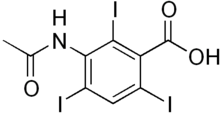|
Acetrizoate was developed by V.H. Wallingford of ], and introduced in 1950;<ref name=McClennan>{{cite journal |author=McClennan BL |title=Preston M. Hickey memorial lecture. Ionic and nonionic iodinated contrast media: evolution and strategies for use |journal=AJR. American Journal of Roentgenology |volume=155 |issue=2 |pages=225–33 |year=1990 |pmid=2115244 |doi=10.2214/ajr.155.2.2115244}}</ref> it was employed as a contrast agent for several radiographic studies, including ],<ref>{{cite journal |vauthors=NESBIT RM, LAPIDES J |title=Preliminary report on urokon, a new excretory pyelographic medium |journal=J Urol |volume=63 |issue=6 |pages=1109–12 |year=1950 |doi=10.1016/s0022-5347(17)68871-2 |pmid=15422724 }}</ref><ref>{{cite journal |vauthors=EYLER WR, DREW DR, BOHNE AW |title=A comparative clinical trial of urographic media: renografin, hypaque, and urokon |journal=Radiology |volume=66 |issue=6 |pages=871–3 |year=1956 |pmid=13323329 |doi=10.1148/66.6.871}}</ref> ] of the ], ] arteries and the ],<ref>{{cite journal |vauthors=LIU P, MURTAGH F, WYCIS HT, SCOTT M |title=Report of one hundred carotid angiograms taken with the new contrast medium acetrizoate (urokon) on Chamberlain's biplane stereoscopic angiographic unit |journal=AMA Archives of Neurology & Psychiatry |volume=69 |issue=5 |pages=651–2 |year=1953 |pmid=13039633 }}</ref><ref>{{cite journal |vauthors=SEAMAN WB, SCHWARTZ HG |title=Cerebral arteriography with sodium acetrizoate (urokon sodium) 30% |journal=AMA Archives of Surgery |volume=67 |issue=5 |pages=741–5 |year=1953 |pmid=13103941 |doi=10.1001/archsurg.1953.01260040752012}}</ref> and ].<ref>{{cite journal |author=ORLOFF TL |title=Intravenous cholecystography with a new medium; experience with sodium acetrizoate (urokon sodium) seventy per cent |journal=AMA Archives of Surgery |volume=71 |issue=4 |pages=620–2 |year=1955 |pmid=13258064 |doi=10.1001/archsurg.1955.01270160146019}}</ref><ref>{{cite journal |vauthors=WOOLLEY IM, KEIZUR LW, MAYERHARNISCH G |title=Gallbladder visualization following the use of 70 per cent sodium acetrizoate (urokon sodium) for intravenous pyelography |journal=Radiology |volume=69 |issue=4 |pages=576–7 |year=1957 |pmid=13485425 |doi=10.1148/69.4.576}}</ref> It was soon found to be highly toxic to the ]s and ]—work urging caution in its administration was published as early as 1959,<ref>{{cite journal |vauthors=LANCE EM, KILLEN DA, SCOTT HW |title=A plea for caution in the use of sodium acetrizoate (urokon) for aortography |journal=Ann Surg |volume=150 |issue=1 |pages=172 |year=1959 |pmid=13661846 |doi=10.1097/00000658-195907000-00022 |pmc=1613496}}</ref> after reports of adverse reactions ranging from hypersensitivity to brain damage—and was eventually replaced by other agents with higher efficacy and lower toxicity, such as ], a closely related compound.<ref name=McClennan/> |
|
Acetrizoate was developed by V.H. Wallingford of ], and introduced in 1950;<ref name=McClennan>{{cite journal |author=McClennan BL |title=Preston M. Hickey memorial lecture. Ionic and nonionic iodinated contrast media: evolution and strategies for use |journal=AJR. American Journal of Roentgenology |volume=155 |issue=2 |pages=225–33 |year=1990 |pmid=2115244 |doi=10.2214/ajr.155.2.2115244}}</ref> it was employed as a contrast agent for several radiographic studies, including ],<ref>{{cite journal |vauthors=NESBIT RM, LAPIDES J |title=Preliminary report on urokon, a new excretory pyelographic medium |journal=J Urol |volume=63 |issue=6 |pages=1109–12 |year=1950 |doi=10.1016/s0022-5347(17)68871-2 |pmid=15422724 }}</ref><ref>{{cite journal |vauthors=EYLER WR, DREW DR, BOHNE AW |title=A comparative clinical trial of urographic media: renografin, hypaque, and urokon |journal=Radiology |volume=66 |issue=6 |pages=871–3 |year=1956 |pmid=13323329 |doi=10.1148/66.6.871}}</ref> ] of the ], ] arteries and the ],<ref>{{cite journal |vauthors=LIU P, MURTAGH F, WYCIS HT, SCOTT M |title=Report of one hundred carotid angiograms taken with the new contrast medium acetrizoate (urokon) on Chamberlain's biplane stereoscopic angiographic unit |journal=A.M.A. Archives of Neurology & Psychiatry |volume=69 |issue=5 |pages=651–2 |year=1953 |pmid=13039633 }}</ref><ref>{{cite journal |vauthors=SEAMAN WB, SCHWARTZ HG |title=Cerebral arteriography with sodium acetrizoate (urokon sodium) 30% |journal=A.M.A. Archives of Surgery |volume=67 |issue=5 |pages=741–5 |year=1953 |pmid=13103941 |doi=10.1001/archsurg.1953.01260040752012}}</ref> and ].<ref>{{cite journal |author=ORLOFF TL |title=Intravenous cholecystography with a new medium; experience with sodium acetrizoate (urokon sodium) seventy per cent |journal=A.M.A. Archives of Surgery |volume=71 |issue=4 |pages=620–2 |year=1955 |pmid=13258064 |doi=10.1001/archsurg.1955.01270160146019}}</ref><ref>{{cite journal |vauthors=WOOLLEY IM, KEIZUR LW, MAYERHARNISCH G |title=Gallbladder visualization following the use of 70 per cent sodium acetrizoate (urokon sodium) for intravenous pyelography |journal=Radiology |volume=69 |issue=4 |pages=576–7 |year=1957 |pmid=13485425 |doi=10.1148/69.4.576}}</ref> It was soon found to be highly toxic to the ]s and ]—work urging caution in its administration was published as early as 1959,<ref>{{cite journal |vauthors=LANCE EM, KILLEN DA, SCOTT HW |title=A plea for caution in the use of sodium acetrizoate (urokon) for aortography |journal=Ann Surg |volume=150 |issue=1 |pages=172 |year=1959 |pmid=13661846 |doi=10.1097/00000658-195907000-00022 |pmc=1613496}}</ref> after reports of adverse reactions ranging from hypersensitivity to brain damage—and was eventually replaced by other agents with higher efficacy and lower toxicity, such as ], a closely related compound.<ref name=McClennan/> |

